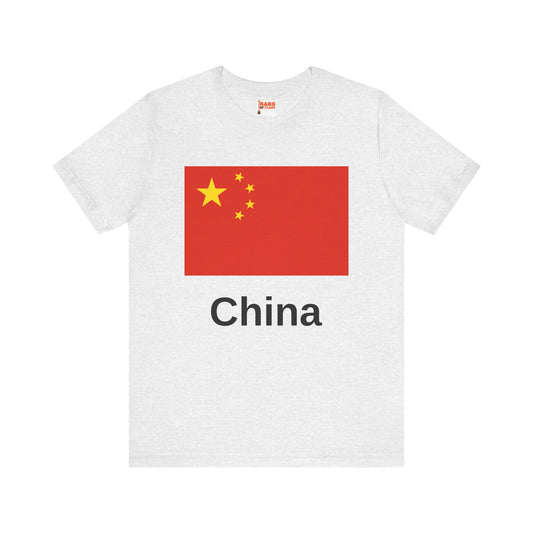-
China Pillow
Regular price $22.65 USDRegular priceUnit price / per -
China Backpack
Regular price $59.79 USDRegular priceUnit price / per -
China Leather Patch Hat
Regular price $18.85 USDRegular priceUnit price / per -
China Sweatshirt
Regular price $34.15 USDRegular priceUnit price / per -
China Flag Sweatshirt
Regular price $34.15 USDRegular priceUnit price / per -
China Inspired Sweatshirt
Regular price $34.15 USDRegular priceUnit price / per -
China Trucker Cap
Regular price $14.90 USDRegular priceUnit price / per -
China Inspired Hoodie
Regular price $34.40 USDRegular priceUnit price / per -
China Hoodies
Regular price $34.40 USDRegular priceUnit price / per -
China T-shirts
Regular price $22.79 USDRegular priceUnit price / per -
China Inspired T-shirt
Regular price $22.79 USDRegular priceUnit price / per -
China Flag on Hoodie
Regular price $34.40 USDRegular priceUnit price / per -
China Flag on T-shirt
Regular price $22.79 USDRegular priceUnit price / per
Collection: China
The Chinese flag is a symbol of the country's rich history and cultural heritage. With its bold red background and five yellow stars, the flag stands out as a powerful emblem of China's unity and strength. We will explore the unique facts and protocols surrounding the Chinese flag, from its design and historical context to its symbolism and current relevance.
Overview of the Flag Design and Colors

The flag of China features a primary backdrop of vibrant red, a color deeply embedded in the country's culture and symbolic of its revolutionary history. In the canton, or upper hoist corner resides a prominent, sizeable golden star surrounded by a semicircle of four smaller stars, each positioned at a point that directs towards the center of the giant star. This arrangement is not just a visual hierarchy but a representation of the central leadership of the Communist Party of China and the harmonious relationship it aims to have with the different classes of society.
The choice of yellow for the stars stands in striking contrast against the red, which emphasizes not only visibility but also the virtues of prosperity and happiness that yellow traditionally signifies in Chinese culture. This color scheme and the specific layout of the stars are crafted to convey a narrative of unity, leadership, and the nation's guiding principles. The design is a calculated representation of the country's political structure and ideological foundations, encapsulated within the simplicity of geometric shapes and bold colors.
Historical Context of the China Flag

Adopted on September 27, 1949, during a significant historical moment just days after the founding of the People's Republic of China, the flag symbolizes a new era following the end of the Chinese Civil War and the communist revolution led by the Communist Party of China. This date marks a profound political and societal shift within the country and the establishment of an emblem that would come to represent China’s aspirations and its path forward on the global stage. The design, proposed by Zeng Liansong, was chosen from over 3,000 submissions in a nationwide contest.
Reflecting the victory of the communist forces, the flag's introduction was a culminating point of years of struggle and ideological battle. The creation and adoption of the flag were intended to foster a sense of unity and renewal among the Chinese people, encapsulating the spirit of resistance, perseverance, and the promise of a revolutionary future. Since its adoption, the flag has remained unchanged, a testament to the enduring values and principles it was designed to embody. It is a constant reminder of the transformative period in China's history, from which the current societal and political landscapes were shaped.
Symbolism Embodied in the Flag
At the heart of the Chinese flag's design lies a rich tapestry of symbolism, each element carefully chosen to reflect core values and political ideologies. The pervasive red backdrop signals the courage and sacrifice of the communist revolution, an enduring reminder of the struggles and triumphs that led to the foundation of the People's Republic of China. This bold color serves as a background and a statement of the revolutionary spirit that underpins the nation's governance and societal structure.
Central to the flag's imagery is the assembly of five stars, a constellation that delineates the harmonious interplay between the Communist Party and the Chinese populace. The principal giant star epitomizes the Communist Party's leading role, asserting its position as the guiding force in China's political landscape. Encircling this beacon are four smaller stars, each angled towards the larger, symbolizing the solidarity among the country's social classes - the working class, the peasantry, the urban petty bourgeoisie, and the national bourgeoisie. Together, these stars illuminate the path toward unity, representing an ideal of collective progress and mutual support within the fabric of Chinese society. This symbolic configuration underscores a national narrative of leadership and cooperation, reflecting the intertwined destinies of the party and the people in building and sustaining the nation.
Current Relevance of the China Flag
In contemporary China, the national flag plays a pivotal role in fostering a sense of patriotism and unity among its citizens. It prominently features at a range of significant public events, including the fervently celebrated National Day and military parades that showcase the country's defense capabilities. Additionally, the flag is a common sight at government buildings, educational institutions, and numerous public spaces as a daily reminder of the nation's identity and values.
The flag's presence extends beyond physical spaces into digital realms, symbolizing Chinese sovereignty and pride on international platforms and during diplomatic engagements. Despite its ubiquitous status, the flag has occasionally sparked debate, particularly regarding governance and civil liberties under the Communist Party's rule. These discussions reflect the diverse perspectives within China and among its global diaspora, underscoring the flag's complex role in contemporary socio-political discourse.
Additional Facts and Protocols Regarding the China Flag
Several unique protocols surround handling and displaying the Chinese flag to maintain its dignity and significance. For instance, there's a precise protocol to ensure its respectful presentation during national celebrations or when the flag is raised every morning in Tiananmen Square. The flag must be hoisted at sunrise and lowered at sunset, aligning with the nation's respect for its symbols. Additionally, strict guidelines exist that the flag should not be flown upside down or in any manner that could be construed as disrespectful.
When the flag is displayed alongside those of other countries, it must be placed in a position of honor, typically at the center or at the highest point. Interestingly, it is also considered improper to use the flag in commercial advertisements or private events that do not have a national significance, underscoring the flag’s exclusive role as a symbol of the state and its ideals. These protocols serve not only to honor the flag but also to reinforce the collective identity and values it represents within the Chinese community and on the international stage.




























